Organisational Theory and Practice Case Study Analysis of ASOS plc
VerifiedAdded on 2022/11/25
|12
|4231
|432
Case Study
AI Summary
This case study analyzes ASOS plc, a British online fashion retailer, through the lens of organisational theory and practice. The study begins with an analysis of the CEO's managerial style, referencing Henry Mintzberg's managerial roles to understand the CEO's leadership approach. It then evaluates the steps taken by the CEO to bring about organisational change, especially in response to the pandemic, examining the impact on organisational structure and culture. The case study further explores the CEO's leadership style to enhance organisational effectiveness, identifying it as democratic. It also examines conflict, influence, and power dynamics within ASOS, and describes the motivation strategies employed by the organisation. The analysis is supported by corporate examples and relevant literature, concluding with suggestions and recommendations to improve organisational performance.
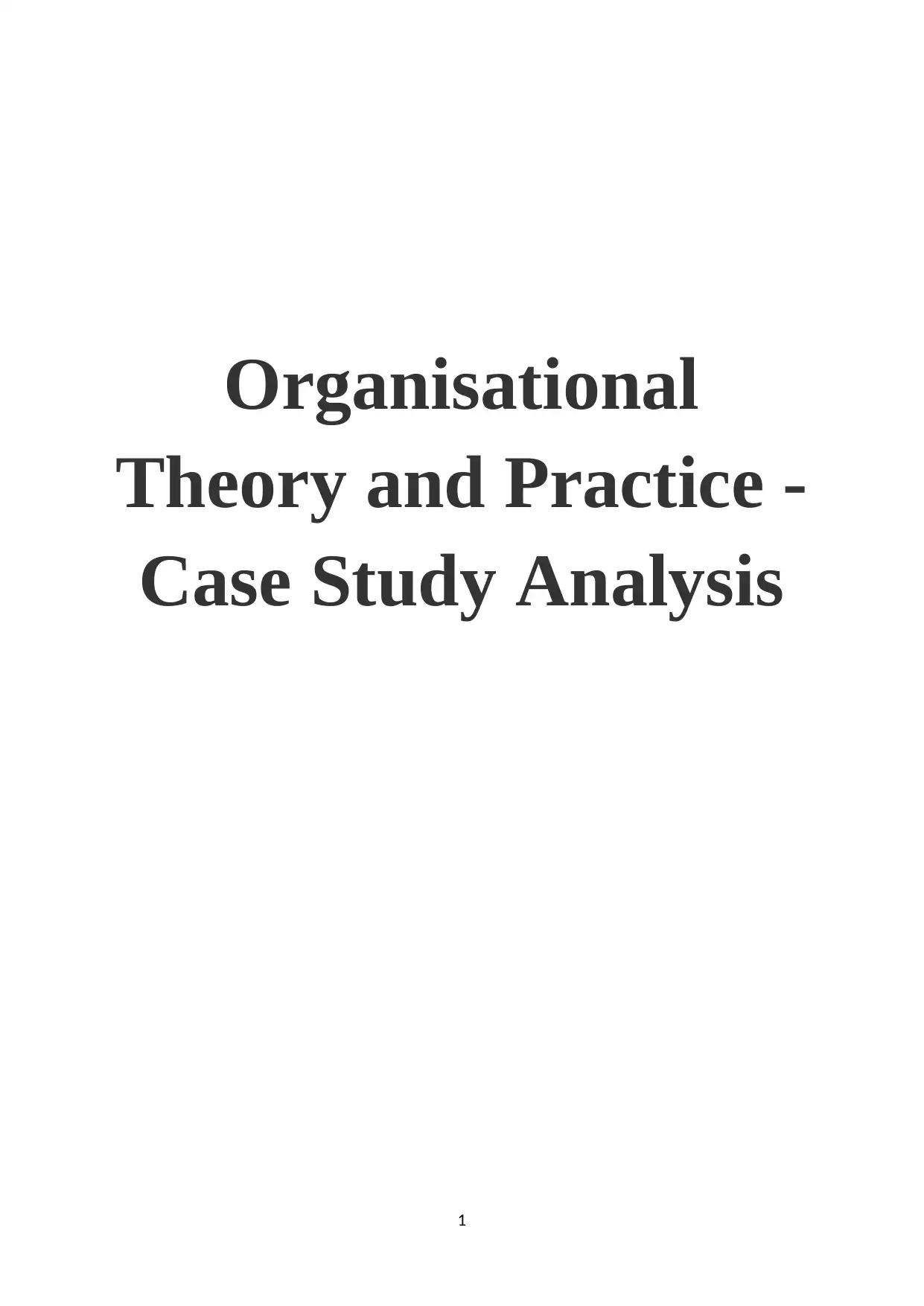
Organisational
Theory and Practice -
Case Study Analysis
1
Theory and Practice -
Case Study Analysis
1
Paraphrase This Document
Need a fresh take? Get an instant paraphrase of this document with our AI Paraphraser
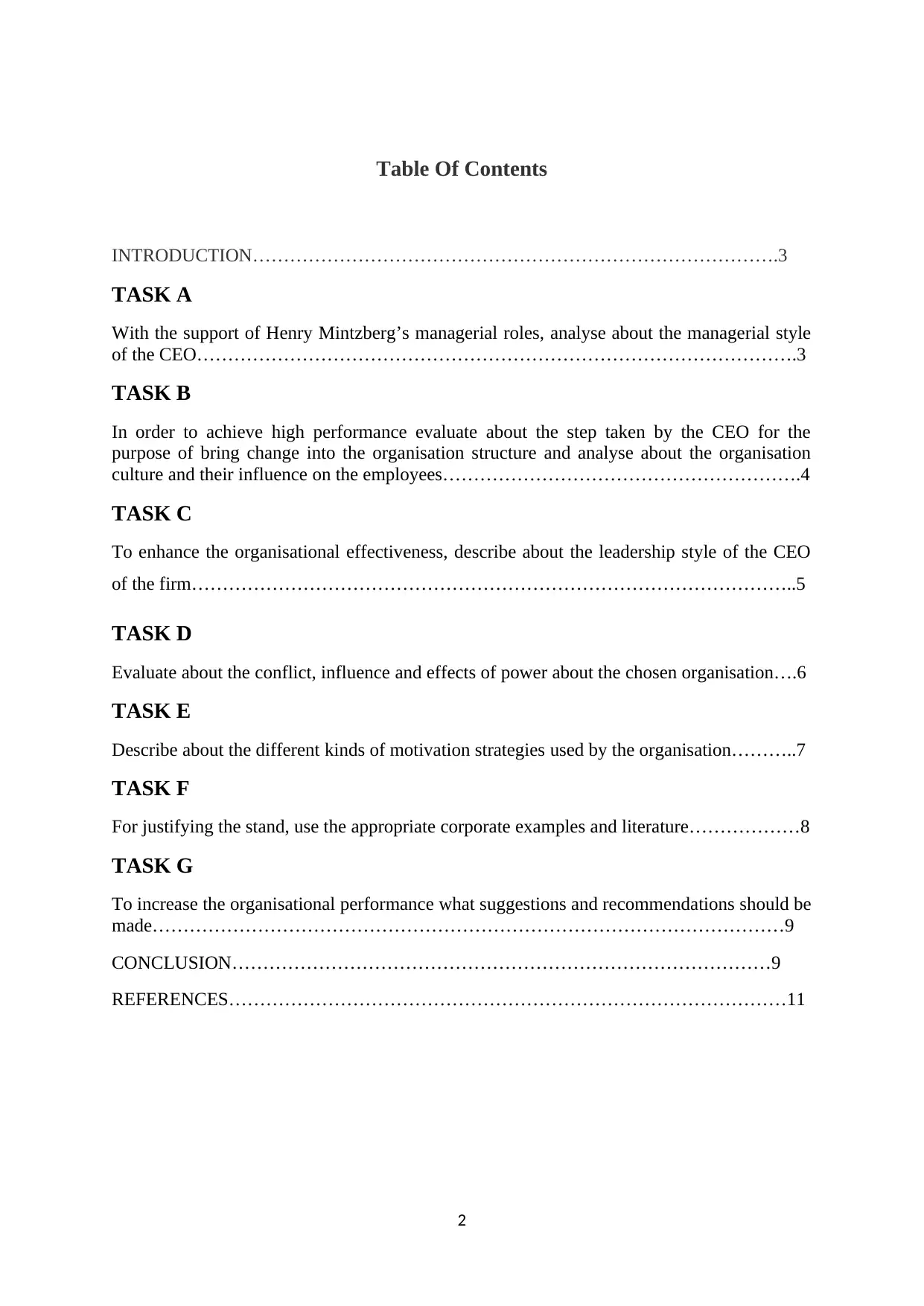
Table Of Contents
INTRODUCTION………………………………………………………………………….3
TASK A
With the support of Henry Mintzberg’s managerial roles, analyse about the managerial style
of the CEO…………………………………………………………………………………….3
TASK B
In order to achieve high performance evaluate about the step taken by the CEO for the
purpose of bring change into the organisation structure and analyse about the organisation
culture and their influence on the employees………………………………………………….4
TASK C
To enhance the organisational effectiveness, describe about the leadership style of the CEO
of the firm……………………………………………………………………………………..5
TASK D
Evaluate about the conflict, influence and effects of power about the chosen organisation….6
TASK E
Describe about the different kinds of motivation strategies used by the organisation………..7
TASK F
For justifying the stand, use the appropriate corporate examples and literature………………8
TASK G
To increase the organisational performance what suggestions and recommendations should be
made…………………………………………………………………………………………9
CONCLUSION……………………………………………………………………………9
REFERENCES………………………………………………………………………………11
2
INTRODUCTION………………………………………………………………………….3
TASK A
With the support of Henry Mintzberg’s managerial roles, analyse about the managerial style
of the CEO…………………………………………………………………………………….3
TASK B
In order to achieve high performance evaluate about the step taken by the CEO for the
purpose of bring change into the organisation structure and analyse about the organisation
culture and their influence on the employees………………………………………………….4
TASK C
To enhance the organisational effectiveness, describe about the leadership style of the CEO
of the firm……………………………………………………………………………………..5
TASK D
Evaluate about the conflict, influence and effects of power about the chosen organisation….6
TASK E
Describe about the different kinds of motivation strategies used by the organisation………..7
TASK F
For justifying the stand, use the appropriate corporate examples and literature………………8
TASK G
To increase the organisational performance what suggestions and recommendations should be
made…………………………………………………………………………………………9
CONCLUSION……………………………………………………………………………9
REFERENCES………………………………………………………………………………11
2
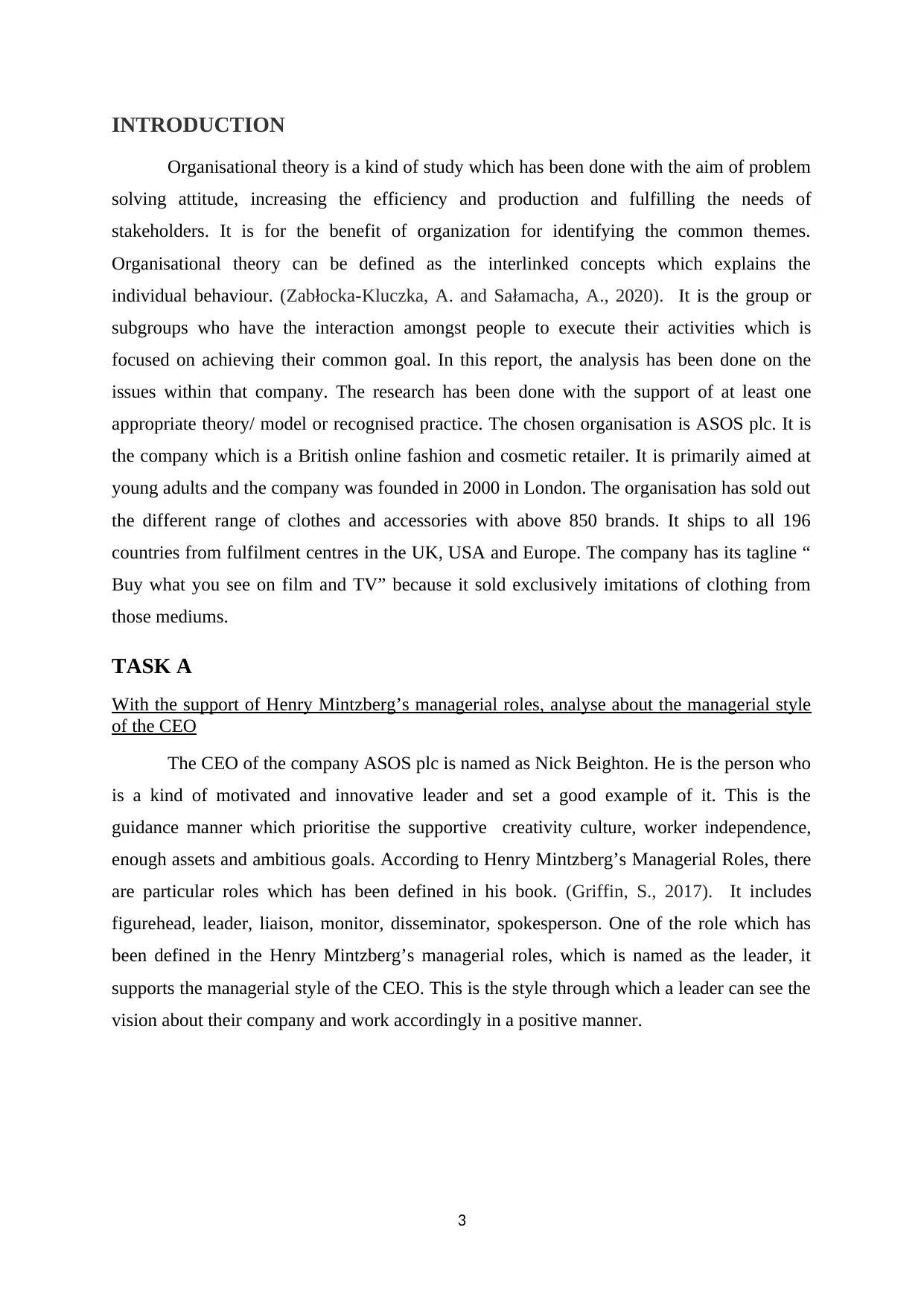
INTRODUCTION
Organisational theory is a kind of study which has been done with the aim of problem
solving attitude, increasing the efficiency and production and fulfilling the needs of
stakeholders. It is for the benefit of organization for identifying the common themes.
Organisational theory can be defined as the interlinked concepts which explains the
individual behaviour. (Zabłocka-Kluczka, A. and Sałamacha, A., 2020). It is the group or
subgroups who have the interaction amongst people to execute their activities which is
focused on achieving their common goal. In this report, the analysis has been done on the
issues within that company. The research has been done with the support of at least one
appropriate theory/ model or recognised practice. The chosen organisation is ASOS plc. It is
the company which is a British online fashion and cosmetic retailer. It is primarily aimed at
young adults and the company was founded in 2000 in London. The organisation has sold out
the different range of clothes and accessories with above 850 brands. It ships to all 196
countries from fulfilment centres in the UK, USA and Europe. The company has its tagline “
Buy what you see on film and TV” because it sold exclusively imitations of clothing from
those mediums.
TASK A
With the support of Henry Mintzberg’s managerial roles, analyse about the managerial style
of the CEO
The CEO of the company ASOS plc is named as Nick Beighton. He is the person who
is a kind of motivated and innovative leader and set a good example of it. This is the
guidance manner which prioritise the supportive creativity culture, worker independence,
enough assets and ambitious goals. According to Henry Mintzberg’s Managerial Roles, there
are particular roles which has been defined in his book. (Griffin, S., 2017). It includes
figurehead, leader, liaison, monitor, disseminator, spokesperson. One of the role which has
been defined in the Henry Mintzberg’s managerial roles, which is named as the leader, it
supports the managerial style of the CEO. This is the style through which a leader can see the
vision about their company and work accordingly in a positive manner.
3
Organisational theory is a kind of study which has been done with the aim of problem
solving attitude, increasing the efficiency and production and fulfilling the needs of
stakeholders. It is for the benefit of organization for identifying the common themes.
Organisational theory can be defined as the interlinked concepts which explains the
individual behaviour. (Zabłocka-Kluczka, A. and Sałamacha, A., 2020). It is the group or
subgroups who have the interaction amongst people to execute their activities which is
focused on achieving their common goal. In this report, the analysis has been done on the
issues within that company. The research has been done with the support of at least one
appropriate theory/ model or recognised practice. The chosen organisation is ASOS plc. It is
the company which is a British online fashion and cosmetic retailer. It is primarily aimed at
young adults and the company was founded in 2000 in London. The organisation has sold out
the different range of clothes and accessories with above 850 brands. It ships to all 196
countries from fulfilment centres in the UK, USA and Europe. The company has its tagline “
Buy what you see on film and TV” because it sold exclusively imitations of clothing from
those mediums.
TASK A
With the support of Henry Mintzberg’s managerial roles, analyse about the managerial style
of the CEO
The CEO of the company ASOS plc is named as Nick Beighton. He is the person who
is a kind of motivated and innovative leader and set a good example of it. This is the
guidance manner which prioritise the supportive creativity culture, worker independence,
enough assets and ambitious goals. According to Henry Mintzberg’s Managerial Roles, there
are particular roles which has been defined in his book. (Griffin, S., 2017). It includes
figurehead, leader, liaison, monitor, disseminator, spokesperson. One of the role which has
been defined in the Henry Mintzberg’s managerial roles, which is named as the leader, it
supports the managerial style of the CEO. This is the style through which a leader can see the
vision about their company and work accordingly in a positive manner.
3
⊘ This is a preview!⊘
Do you want full access?
Subscribe today to unlock all pages.

Trusted by 1+ million students worldwide
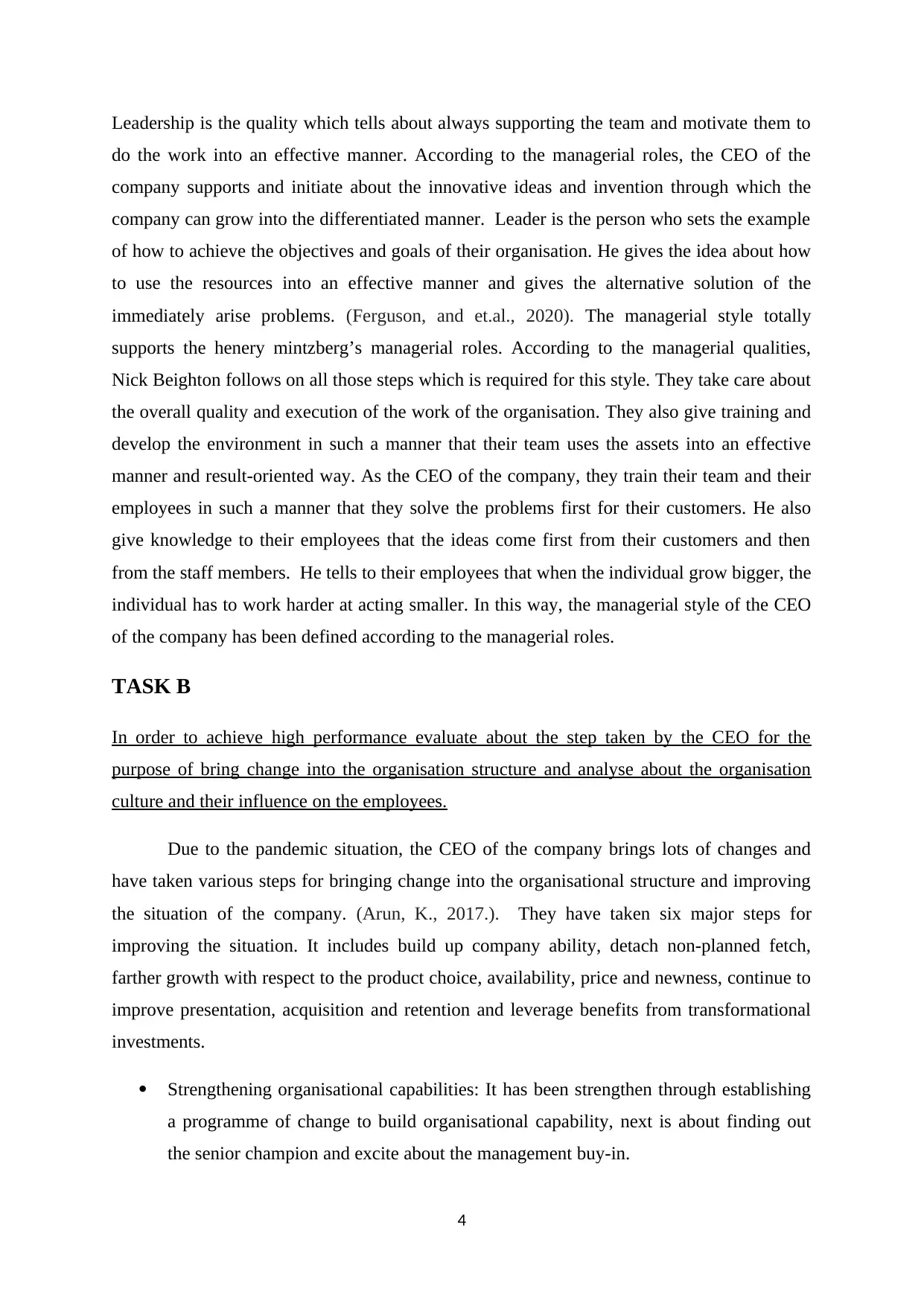
Leadership is the quality which tells about always supporting the team and motivate them to
do the work into an effective manner. According to the managerial roles, the CEO of the
company supports and initiate about the innovative ideas and invention through which the
company can grow into the differentiated manner. Leader is the person who sets the example
of how to achieve the objectives and goals of their organisation. He gives the idea about how
to use the resources into an effective manner and gives the alternative solution of the
immediately arise problems. (Ferguson, and et.al., 2020). The managerial style totally
supports the henery mintzberg’s managerial roles. According to the managerial qualities,
Nick Beighton follows on all those steps which is required for this style. They take care about
the overall quality and execution of the work of the organisation. They also give training and
develop the environment in such a manner that their team uses the assets into an effective
manner and result-oriented way. As the CEO of the company, they train their team and their
employees in such a manner that they solve the problems first for their customers. He also
give knowledge to their employees that the ideas come first from their customers and then
from the staff members. He tells to their employees that when the individual grow bigger, the
individual has to work harder at acting smaller. In this way, the managerial style of the CEO
of the company has been defined according to the managerial roles.
TASK B
In order to achieve high performance evaluate about the step taken by the CEO for the
purpose of bring change into the organisation structure and analyse about the organisation
culture and their influence on the employees.
Due to the pandemic situation, the CEO of the company brings lots of changes and
have taken various steps for bringing change into the organisational structure and improving
the situation of the company. (Arun, K., 2017.). They have taken six major steps for
improving the situation. It includes build up company ability, detach non-planned fetch,
farther growth with respect to the product choice, availability, price and newness, continue to
improve presentation, acquisition and retention and leverage benefits from transformational
investments.
Strengthening organisational capabilities: It has been strengthen through establishing
a programme of change to build organisational capability, next is about finding out
the senior champion and excite about the management buy-in.
4
do the work into an effective manner. According to the managerial roles, the CEO of the
company supports and initiate about the innovative ideas and invention through which the
company can grow into the differentiated manner. Leader is the person who sets the example
of how to achieve the objectives and goals of their organisation. He gives the idea about how
to use the resources into an effective manner and gives the alternative solution of the
immediately arise problems. (Ferguson, and et.al., 2020). The managerial style totally
supports the henery mintzberg’s managerial roles. According to the managerial qualities,
Nick Beighton follows on all those steps which is required for this style. They take care about
the overall quality and execution of the work of the organisation. They also give training and
develop the environment in such a manner that their team uses the assets into an effective
manner and result-oriented way. As the CEO of the company, they train their team and their
employees in such a manner that they solve the problems first for their customers. He also
give knowledge to their employees that the ideas come first from their customers and then
from the staff members. He tells to their employees that when the individual grow bigger, the
individual has to work harder at acting smaller. In this way, the managerial style of the CEO
of the company has been defined according to the managerial roles.
TASK B
In order to achieve high performance evaluate about the step taken by the CEO for the
purpose of bring change into the organisation structure and analyse about the organisation
culture and their influence on the employees.
Due to the pandemic situation, the CEO of the company brings lots of changes and
have taken various steps for bringing change into the organisational structure and improving
the situation of the company. (Arun, K., 2017.). They have taken six major steps for
improving the situation. It includes build up company ability, detach non-planned fetch,
farther growth with respect to the product choice, availability, price and newness, continue to
improve presentation, acquisition and retention and leverage benefits from transformational
investments.
Strengthening organisational capabilities: It has been strengthen through establishing
a programme of change to build organisational capability, next is about finding out
the senior champion and excite about the management buy-in.
4
Paraphrase This Document
Need a fresh take? Get an instant paraphrase of this document with our AI Paraphraser
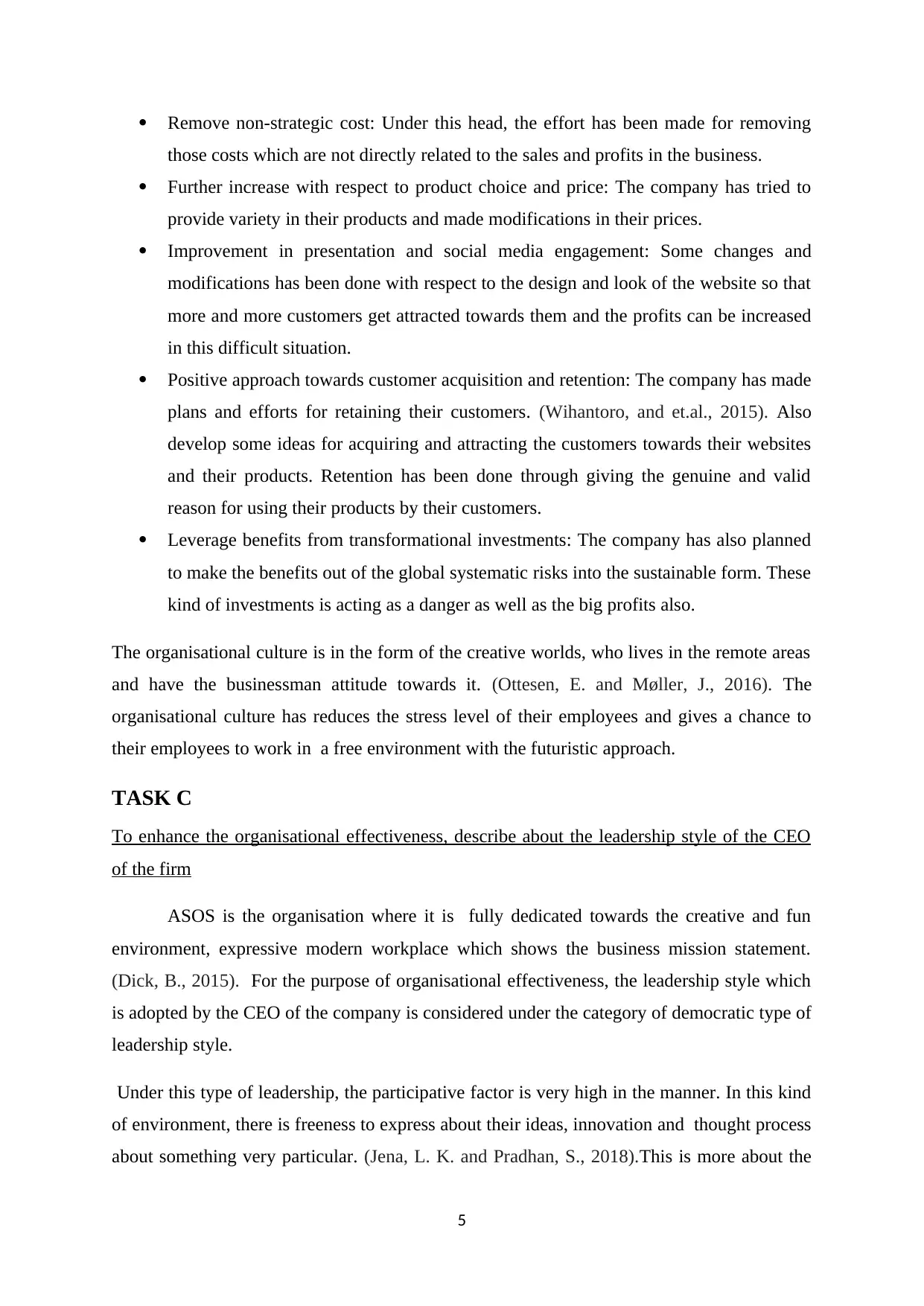
Remove non-strategic cost: Under this head, the effort has been made for removing
those costs which are not directly related to the sales and profits in the business.
Further increase with respect to product choice and price: The company has tried to
provide variety in their products and made modifications in their prices.
Improvement in presentation and social media engagement: Some changes and
modifications has been done with respect to the design and look of the website so that
more and more customers get attracted towards them and the profits can be increased
in this difficult situation.
Positive approach towards customer acquisition and retention: The company has made
plans and efforts for retaining their customers. (Wihantoro, and et.al., 2015). Also
develop some ideas for acquiring and attracting the customers towards their websites
and their products. Retention has been done through giving the genuine and valid
reason for using their products by their customers.
Leverage benefits from transformational investments: The company has also planned
to make the benefits out of the global systematic risks into the sustainable form. These
kind of investments is acting as a danger as well as the big profits also.
The organisational culture is in the form of the creative worlds, who lives in the remote areas
and have the businessman attitude towards it. (Ottesen, E. and Møller, J., 2016). The
organisational culture has reduces the stress level of their employees and gives a chance to
their employees to work in a free environment with the futuristic approach.
TASK C
To enhance the organisational effectiveness, describe about the leadership style of the CEO
of the firm
ASOS is the organisation where it is fully dedicated towards the creative and fun
environment, expressive modern workplace which shows the business mission statement.
(Dick, B., 2015). For the purpose of organisational effectiveness, the leadership style which
is adopted by the CEO of the company is considered under the category of democratic type of
leadership style.
Under this type of leadership, the participative factor is very high in the manner. In this kind
of environment, there is freeness to express about their ideas, innovation and thought process
about something very particular. (Jena, L. K. and Pradhan, S., 2018).This is more about the
5
those costs which are not directly related to the sales and profits in the business.
Further increase with respect to product choice and price: The company has tried to
provide variety in their products and made modifications in their prices.
Improvement in presentation and social media engagement: Some changes and
modifications has been done with respect to the design and look of the website so that
more and more customers get attracted towards them and the profits can be increased
in this difficult situation.
Positive approach towards customer acquisition and retention: The company has made
plans and efforts for retaining their customers. (Wihantoro, and et.al., 2015). Also
develop some ideas for acquiring and attracting the customers towards their websites
and their products. Retention has been done through giving the genuine and valid
reason for using their products by their customers.
Leverage benefits from transformational investments: The company has also planned
to make the benefits out of the global systematic risks into the sustainable form. These
kind of investments is acting as a danger as well as the big profits also.
The organisational culture is in the form of the creative worlds, who lives in the remote areas
and have the businessman attitude towards it. (Ottesen, E. and Møller, J., 2016). The
organisational culture has reduces the stress level of their employees and gives a chance to
their employees to work in a free environment with the futuristic approach.
TASK C
To enhance the organisational effectiveness, describe about the leadership style of the CEO
of the firm
ASOS is the organisation where it is fully dedicated towards the creative and fun
environment, expressive modern workplace which shows the business mission statement.
(Dick, B., 2015). For the purpose of organisational effectiveness, the leadership style which
is adopted by the CEO of the company is considered under the category of democratic type of
leadership style.
Under this type of leadership, the participative factor is very high in the manner. In this kind
of environment, there is freeness to express about their ideas, innovation and thought process
about something very particular. (Jena, L. K. and Pradhan, S., 2018).This is more about the
5
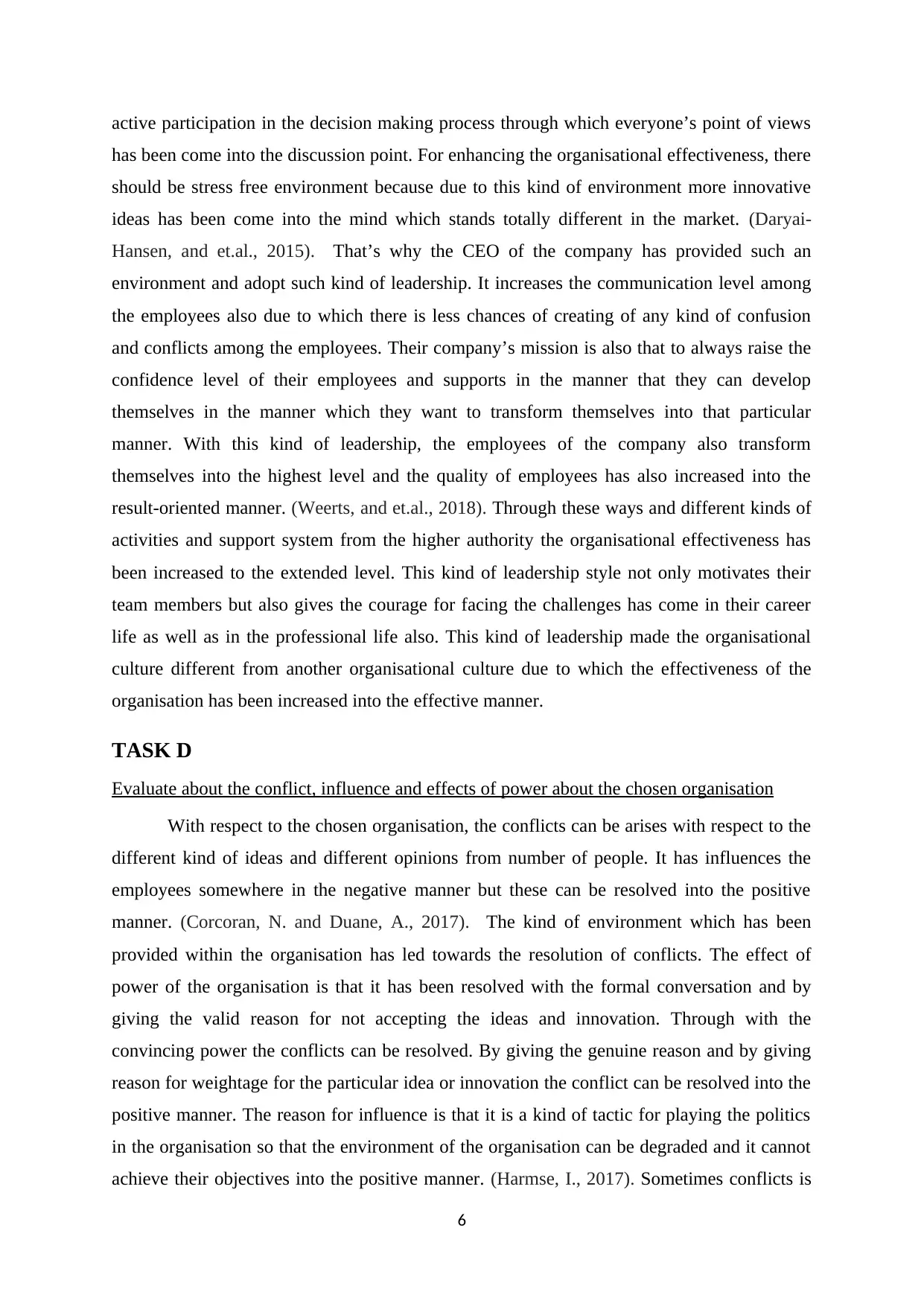
active participation in the decision making process through which everyone’s point of views
has been come into the discussion point. For enhancing the organisational effectiveness, there
should be stress free environment because due to this kind of environment more innovative
ideas has been come into the mind which stands totally different in the market. (Daryai-
Hansen, and et.al., 2015). That’s why the CEO of the company has provided such an
environment and adopt such kind of leadership. It increases the communication level among
the employees also due to which there is less chances of creating of any kind of confusion
and conflicts among the employees. Their company’s mission is also that to always raise the
confidence level of their employees and supports in the manner that they can develop
themselves in the manner which they want to transform themselves into that particular
manner. With this kind of leadership, the employees of the company also transform
themselves into the highest level and the quality of employees has also increased into the
result-oriented manner. (Weerts, and et.al., 2018). Through these ways and different kinds of
activities and support system from the higher authority the organisational effectiveness has
been increased to the extended level. This kind of leadership style not only motivates their
team members but also gives the courage for facing the challenges has come in their career
life as well as in the professional life also. This kind of leadership made the organisational
culture different from another organisational culture due to which the effectiveness of the
organisation has been increased into the effective manner.
TASK D
Evaluate about the conflict, influence and effects of power about the chosen organisation
With respect to the chosen organisation, the conflicts can be arises with respect to the
different kind of ideas and different opinions from number of people. It has influences the
employees somewhere in the negative manner but these can be resolved into the positive
manner. (Corcoran, N. and Duane, A., 2017). The kind of environment which has been
provided within the organisation has led towards the resolution of conflicts. The effect of
power of the organisation is that it has been resolved with the formal conversation and by
giving the valid reason for not accepting the ideas and innovation. Through with the
convincing power the conflicts can be resolved. By giving the genuine reason and by giving
reason for weightage for the particular idea or innovation the conflict can be resolved into the
positive manner. The reason for influence is that it is a kind of tactic for playing the politics
in the organisation so that the environment of the organisation can be degraded and it cannot
achieve their objectives into the positive manner. (Harmse, I., 2017). Sometimes conflicts is
6
has been come into the discussion point. For enhancing the organisational effectiveness, there
should be stress free environment because due to this kind of environment more innovative
ideas has been come into the mind which stands totally different in the market. (Daryai-
Hansen, and et.al., 2015). That’s why the CEO of the company has provided such an
environment and adopt such kind of leadership. It increases the communication level among
the employees also due to which there is less chances of creating of any kind of confusion
and conflicts among the employees. Their company’s mission is also that to always raise the
confidence level of their employees and supports in the manner that they can develop
themselves in the manner which they want to transform themselves into that particular
manner. With this kind of leadership, the employees of the company also transform
themselves into the highest level and the quality of employees has also increased into the
result-oriented manner. (Weerts, and et.al., 2018). Through these ways and different kinds of
activities and support system from the higher authority the organisational effectiveness has
been increased to the extended level. This kind of leadership style not only motivates their
team members but also gives the courage for facing the challenges has come in their career
life as well as in the professional life also. This kind of leadership made the organisational
culture different from another organisational culture due to which the effectiveness of the
organisation has been increased into the effective manner.
TASK D
Evaluate about the conflict, influence and effects of power about the chosen organisation
With respect to the chosen organisation, the conflicts can be arises with respect to the
different kind of ideas and different opinions from number of people. It has influences the
employees somewhere in the negative manner but these can be resolved into the positive
manner. (Corcoran, N. and Duane, A., 2017). The kind of environment which has been
provided within the organisation has led towards the resolution of conflicts. The effect of
power of the organisation is that it has been resolved with the formal conversation and by
giving the valid reason for not accepting the ideas and innovation. Through with the
convincing power the conflicts can be resolved. By giving the genuine reason and by giving
reason for weightage for the particular idea or innovation the conflict can be resolved into the
positive manner. The reason for influence is that it is a kind of tactic for playing the politics
in the organisation so that the environment of the organisation can be degraded and it cannot
achieve their objectives into the positive manner. (Harmse, I., 2017). Sometimes conflicts is
6
⊘ This is a preview!⊘
Do you want full access?
Subscribe today to unlock all pages.

Trusted by 1+ million students worldwide
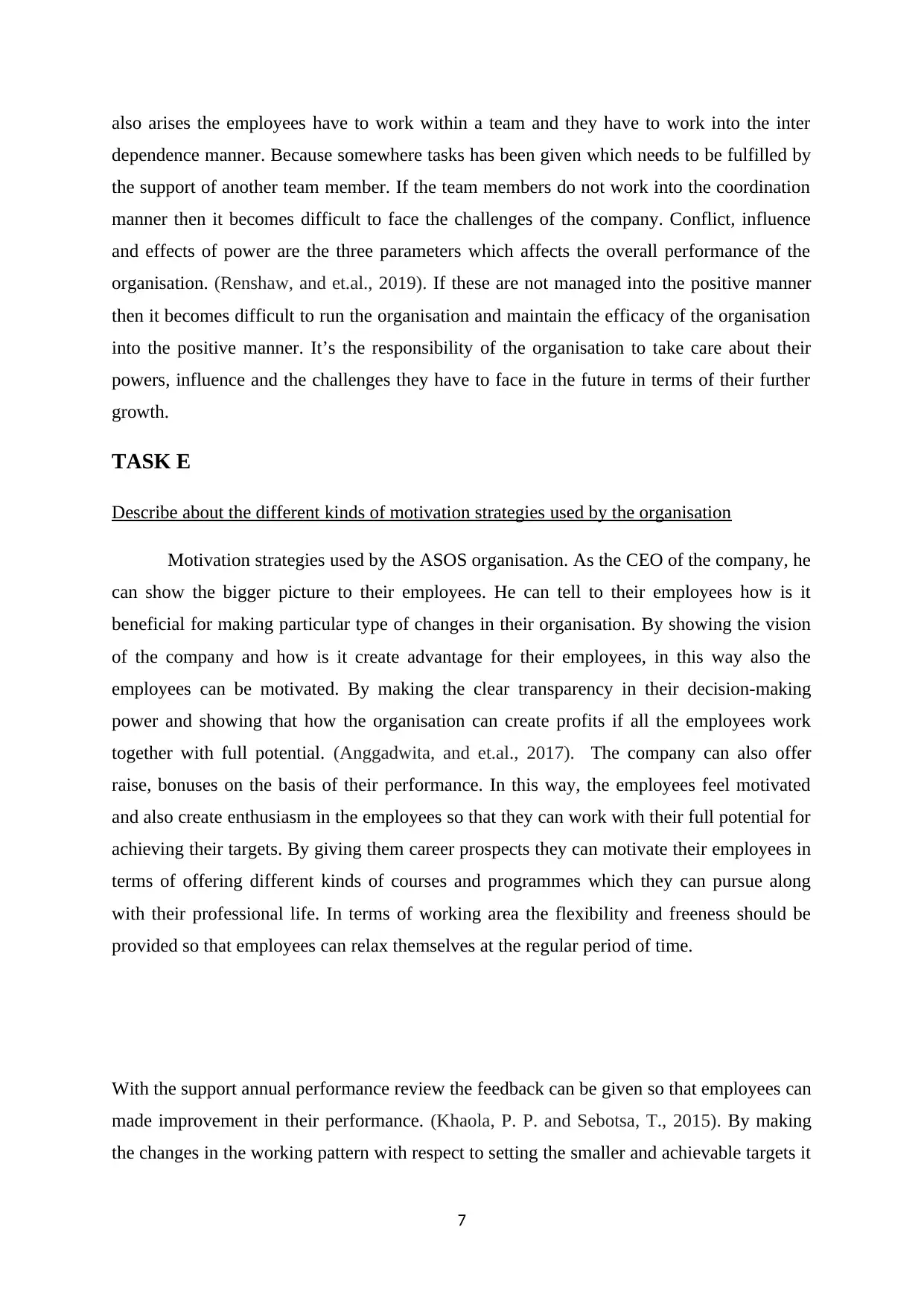
also arises the employees have to work within a team and they have to work into the inter
dependence manner. Because somewhere tasks has been given which needs to be fulfilled by
the support of another team member. If the team members do not work into the coordination
manner then it becomes difficult to face the challenges of the company. Conflict, influence
and effects of power are the three parameters which affects the overall performance of the
organisation. (Renshaw, and et.al., 2019). If these are not managed into the positive manner
then it becomes difficult to run the organisation and maintain the efficacy of the organisation
into the positive manner. It’s the responsibility of the organisation to take care about their
powers, influence and the challenges they have to face in the future in terms of their further
growth.
TASK E
Describe about the different kinds of motivation strategies used by the organisation
Motivation strategies used by the ASOS organisation. As the CEO of the company, he
can show the bigger picture to their employees. He can tell to their employees how is it
beneficial for making particular type of changes in their organisation. By showing the vision
of the company and how is it create advantage for their employees, in this way also the
employees can be motivated. By making the clear transparency in their decision-making
power and showing that how the organisation can create profits if all the employees work
together with full potential. (Anggadwita, and et.al., 2017). The company can also offer
raise, bonuses on the basis of their performance. In this way, the employees feel motivated
and also create enthusiasm in the employees so that they can work with their full potential for
achieving their targets. By giving them career prospects they can motivate their employees in
terms of offering different kinds of courses and programmes which they can pursue along
with their professional life. In terms of working area the flexibility and freeness should be
provided so that employees can relax themselves at the regular period of time.
With the support annual performance review the feedback can be given so that employees can
made improvement in their performance. (Khaola, P. P. and Sebotsa, T., 2015). By making
the changes in the working pattern with respect to setting the smaller and achievable targets it
7
dependence manner. Because somewhere tasks has been given which needs to be fulfilled by
the support of another team member. If the team members do not work into the coordination
manner then it becomes difficult to face the challenges of the company. Conflict, influence
and effects of power are the three parameters which affects the overall performance of the
organisation. (Renshaw, and et.al., 2019). If these are not managed into the positive manner
then it becomes difficult to run the organisation and maintain the efficacy of the organisation
into the positive manner. It’s the responsibility of the organisation to take care about their
powers, influence and the challenges they have to face in the future in terms of their further
growth.
TASK E
Describe about the different kinds of motivation strategies used by the organisation
Motivation strategies used by the ASOS organisation. As the CEO of the company, he
can show the bigger picture to their employees. He can tell to their employees how is it
beneficial for making particular type of changes in their organisation. By showing the vision
of the company and how is it create advantage for their employees, in this way also the
employees can be motivated. By making the clear transparency in their decision-making
power and showing that how the organisation can create profits if all the employees work
together with full potential. (Anggadwita, and et.al., 2017). The company can also offer
raise, bonuses on the basis of their performance. In this way, the employees feel motivated
and also create enthusiasm in the employees so that they can work with their full potential for
achieving their targets. By giving them career prospects they can motivate their employees in
terms of offering different kinds of courses and programmes which they can pursue along
with their professional life. In terms of working area the flexibility and freeness should be
provided so that employees can relax themselves at the regular period of time.
With the support annual performance review the feedback can be given so that employees can
made improvement in their performance. (Khaola, P. P. and Sebotsa, T., 2015). By making
the changes in the working pattern with respect to setting the smaller and achievable targets it
7
Paraphrase This Document
Need a fresh take? Get an instant paraphrase of this document with our AI Paraphraser
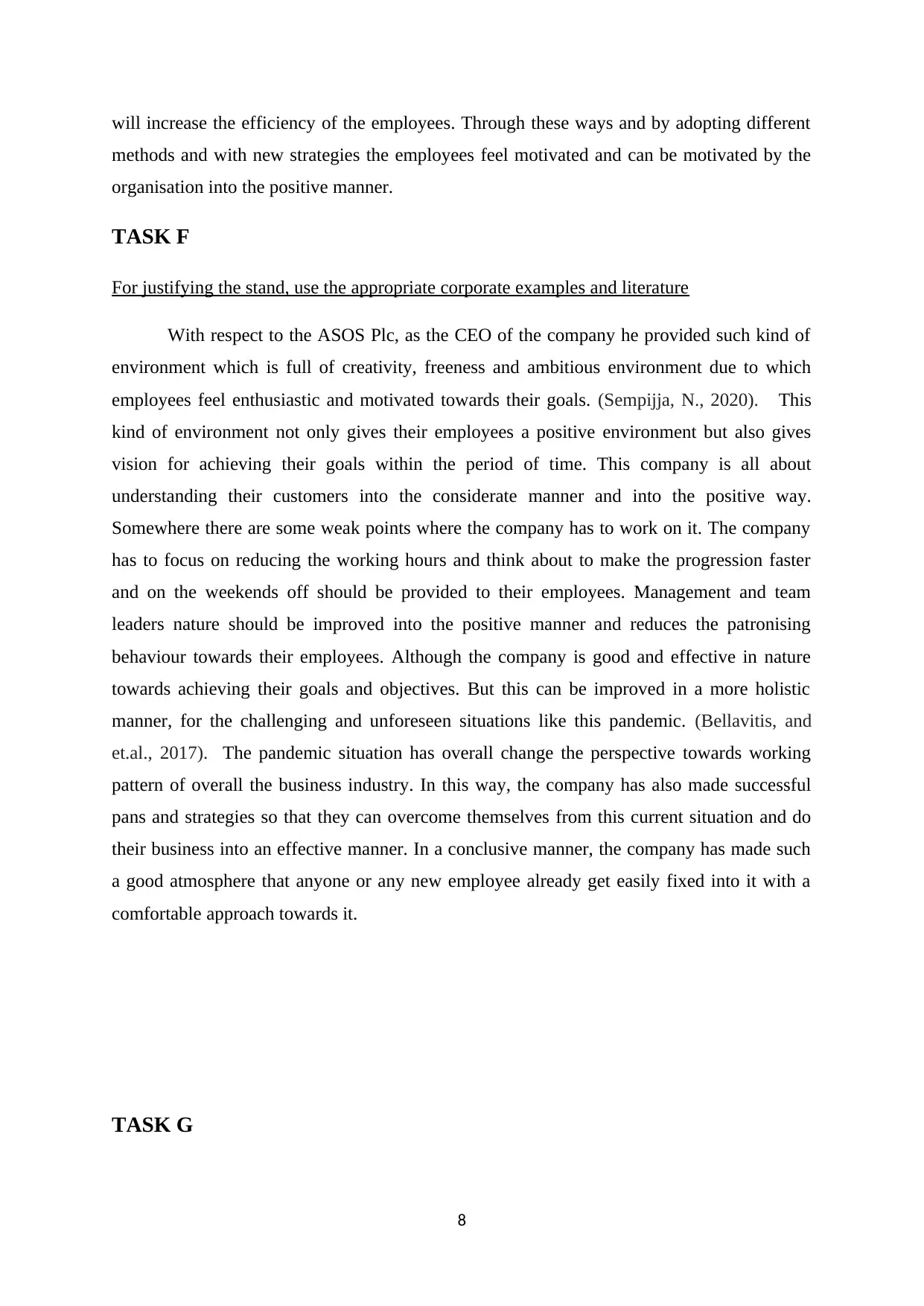
will increase the efficiency of the employees. Through these ways and by adopting different
methods and with new strategies the employees feel motivated and can be motivated by the
organisation into the positive manner.
TASK F
For justifying the stand, use the appropriate corporate examples and literature
With respect to the ASOS Plc, as the CEO of the company he provided such kind of
environment which is full of creativity, freeness and ambitious environment due to which
employees feel enthusiastic and motivated towards their goals. (Sempijja, N., 2020). This
kind of environment not only gives their employees a positive environment but also gives
vision for achieving their goals within the period of time. This company is all about
understanding their customers into the considerate manner and into the positive way.
Somewhere there are some weak points where the company has to work on it. The company
has to focus on reducing the working hours and think about to make the progression faster
and on the weekends off should be provided to their employees. Management and team
leaders nature should be improved into the positive manner and reduces the patronising
behaviour towards their employees. Although the company is good and effective in nature
towards achieving their goals and objectives. But this can be improved in a more holistic
manner, for the challenging and unforeseen situations like this pandemic. (Bellavitis, and
et.al., 2017). The pandemic situation has overall change the perspective towards working
pattern of overall the business industry. In this way, the company has also made successful
pans and strategies so that they can overcome themselves from this current situation and do
their business into an effective manner. In a conclusive manner, the company has made such
a good atmosphere that anyone or any new employee already get easily fixed into it with a
comfortable approach towards it.
TASK G
8
methods and with new strategies the employees feel motivated and can be motivated by the
organisation into the positive manner.
TASK F
For justifying the stand, use the appropriate corporate examples and literature
With respect to the ASOS Plc, as the CEO of the company he provided such kind of
environment which is full of creativity, freeness and ambitious environment due to which
employees feel enthusiastic and motivated towards their goals. (Sempijja, N., 2020). This
kind of environment not only gives their employees a positive environment but also gives
vision for achieving their goals within the period of time. This company is all about
understanding their customers into the considerate manner and into the positive way.
Somewhere there are some weak points where the company has to work on it. The company
has to focus on reducing the working hours and think about to make the progression faster
and on the weekends off should be provided to their employees. Management and team
leaders nature should be improved into the positive manner and reduces the patronising
behaviour towards their employees. Although the company is good and effective in nature
towards achieving their goals and objectives. But this can be improved in a more holistic
manner, for the challenging and unforeseen situations like this pandemic. (Bellavitis, and
et.al., 2017). The pandemic situation has overall change the perspective towards working
pattern of overall the business industry. In this way, the company has also made successful
pans and strategies so that they can overcome themselves from this current situation and do
their business into an effective manner. In a conclusive manner, the company has made such
a good atmosphere that anyone or any new employee already get easily fixed into it with a
comfortable approach towards it.
TASK G
8
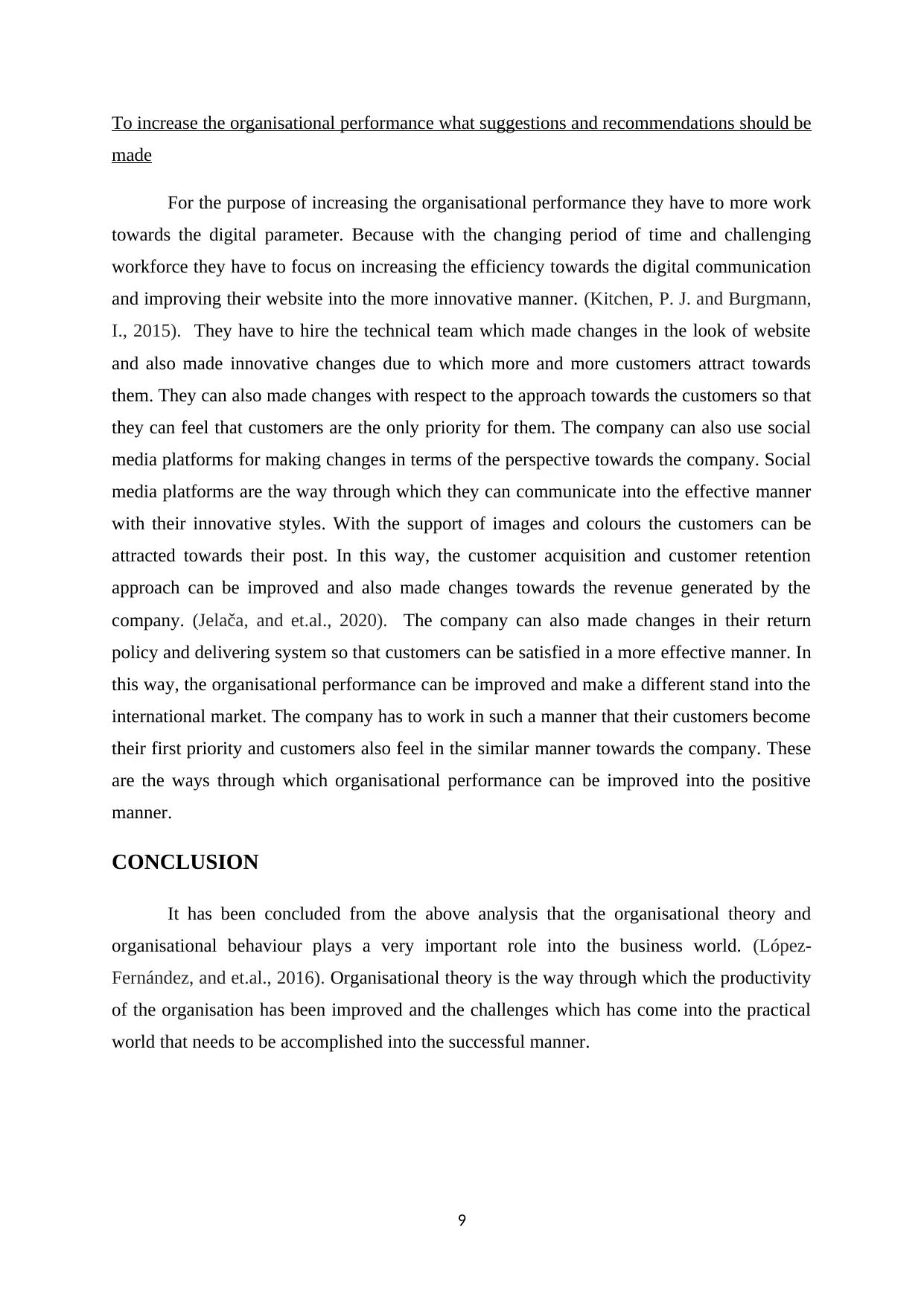
To increase the organisational performance what suggestions and recommendations should be
made
For the purpose of increasing the organisational performance they have to more work
towards the digital parameter. Because with the changing period of time and challenging
workforce they have to focus on increasing the efficiency towards the digital communication
and improving their website into the more innovative manner. (Kitchen, P. J. and Burgmann,
I., 2015). They have to hire the technical team which made changes in the look of website
and also made innovative changes due to which more and more customers attract towards
them. They can also made changes with respect to the approach towards the customers so that
they can feel that customers are the only priority for them. The company can also use social
media platforms for making changes in terms of the perspective towards the company. Social
media platforms are the way through which they can communicate into the effective manner
with their innovative styles. With the support of images and colours the customers can be
attracted towards their post. In this way, the customer acquisition and customer retention
approach can be improved and also made changes towards the revenue generated by the
company. (Jelača, and et.al., 2020). The company can also made changes in their return
policy and delivering system so that customers can be satisfied in a more effective manner. In
this way, the organisational performance can be improved and make a different stand into the
international market. The company has to work in such a manner that their customers become
their first priority and customers also feel in the similar manner towards the company. These
are the ways through which organisational performance can be improved into the positive
manner.
CONCLUSION
It has been concluded from the above analysis that the organisational theory and
organisational behaviour plays a very important role into the business world. (López‐
Fernández, and et.al., 2016). Organisational theory is the way through which the productivity
of the organisation has been improved and the challenges which has come into the practical
world that needs to be accomplished into the successful manner.
9
made
For the purpose of increasing the organisational performance they have to more work
towards the digital parameter. Because with the changing period of time and challenging
workforce they have to focus on increasing the efficiency towards the digital communication
and improving their website into the more innovative manner. (Kitchen, P. J. and Burgmann,
I., 2015). They have to hire the technical team which made changes in the look of website
and also made innovative changes due to which more and more customers attract towards
them. They can also made changes with respect to the approach towards the customers so that
they can feel that customers are the only priority for them. The company can also use social
media platforms for making changes in terms of the perspective towards the company. Social
media platforms are the way through which they can communicate into the effective manner
with their innovative styles. With the support of images and colours the customers can be
attracted towards their post. In this way, the customer acquisition and customer retention
approach can be improved and also made changes towards the revenue generated by the
company. (Jelača, and et.al., 2020). The company can also made changes in their return
policy and delivering system so that customers can be satisfied in a more effective manner. In
this way, the organisational performance can be improved and make a different stand into the
international market. The company has to work in such a manner that their customers become
their first priority and customers also feel in the similar manner towards the company. These
are the ways through which organisational performance can be improved into the positive
manner.
CONCLUSION
It has been concluded from the above analysis that the organisational theory and
organisational behaviour plays a very important role into the business world. (López‐
Fernández, and et.al., 2016). Organisational theory is the way through which the productivity
of the organisation has been improved and the challenges which has come into the practical
world that needs to be accomplished into the successful manner.
9
⊘ This is a preview!⊘
Do you want full access?
Subscribe today to unlock all pages.

Trusted by 1+ million students worldwide
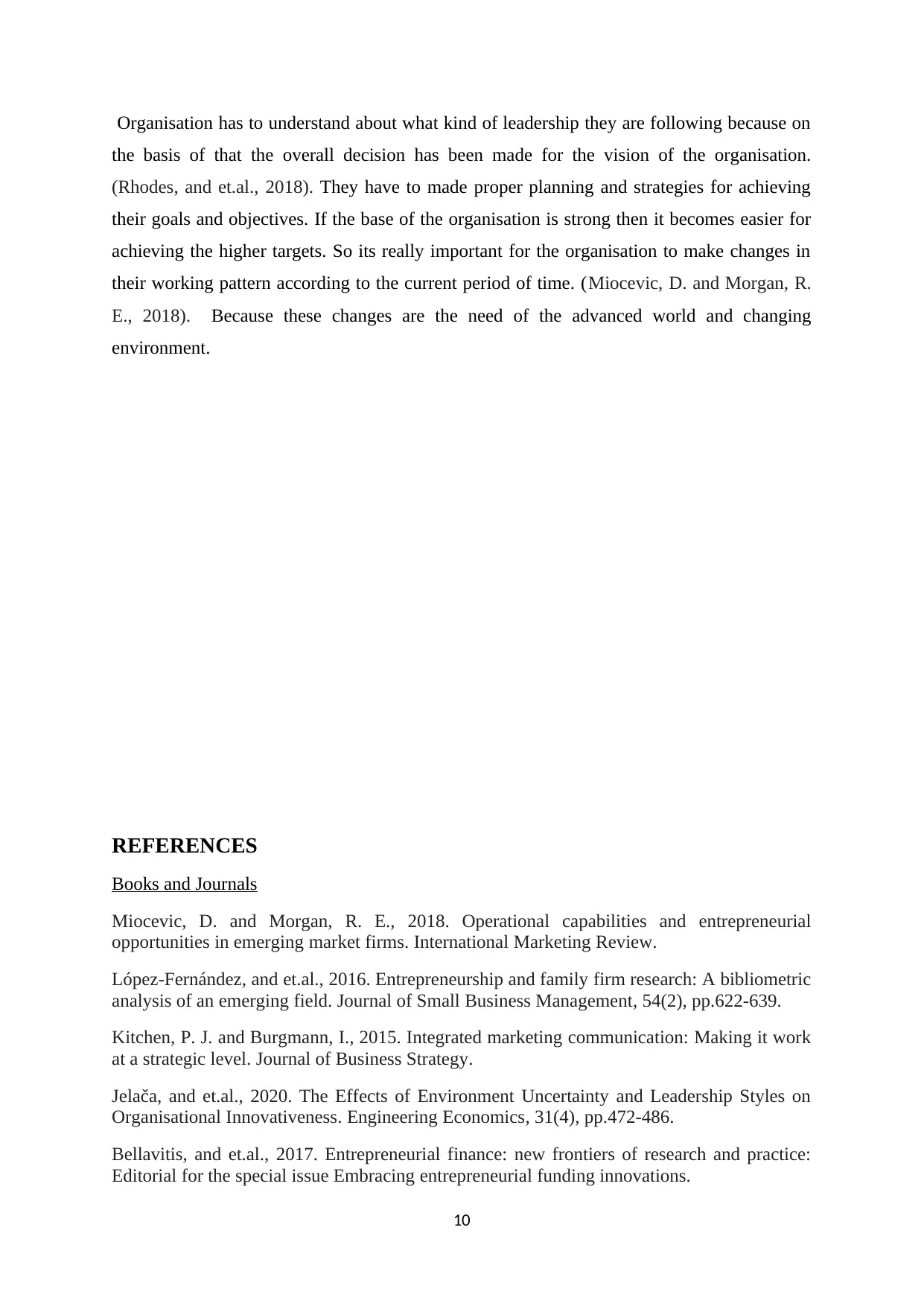
Organisation has to understand about what kind of leadership they are following because on
the basis of that the overall decision has been made for the vision of the organisation.
(Rhodes, and et.al., 2018). They have to made proper planning and strategies for achieving
their goals and objectives. If the base of the organisation is strong then it becomes easier for
achieving the higher targets. So its really important for the organisation to make changes in
their working pattern according to the current period of time. (Miocevic, D. and Morgan, R.
E., 2018). Because these changes are the need of the advanced world and changing
environment.
REFERENCES
Books and Journals
Miocevic, D. and Morgan, R. E., 2018. Operational capabilities and entrepreneurial
opportunities in emerging market firms. International Marketing Review.
López‐Fernández, and et.al., 2016. Entrepreneurship and family firm research: A bibliometric
analysis of an emerging field. Journal of Small Business Management, 54(2), pp.622-639.
Kitchen, P. J. and Burgmann, I., 2015. Integrated marketing communication: Making it work
at a strategic level. Journal of Business Strategy.
Jelača, and et.al., 2020. The Effects of Environment Uncertainty and Leadership Styles on
Organisational Innovativeness. Engineering Economics, 31(4), pp.472-486.
Bellavitis, and et.al., 2017. Entrepreneurial finance: new frontiers of research and practice:
Editorial for the special issue Embracing entrepreneurial funding innovations.
10
the basis of that the overall decision has been made for the vision of the organisation.
(Rhodes, and et.al., 2018). They have to made proper planning and strategies for achieving
their goals and objectives. If the base of the organisation is strong then it becomes easier for
achieving the higher targets. So its really important for the organisation to make changes in
their working pattern according to the current period of time. (Miocevic, D. and Morgan, R.
E., 2018). Because these changes are the need of the advanced world and changing
environment.
REFERENCES
Books and Journals
Miocevic, D. and Morgan, R. E., 2018. Operational capabilities and entrepreneurial
opportunities in emerging market firms. International Marketing Review.
López‐Fernández, and et.al., 2016. Entrepreneurship and family firm research: A bibliometric
analysis of an emerging field. Journal of Small Business Management, 54(2), pp.622-639.
Kitchen, P. J. and Burgmann, I., 2015. Integrated marketing communication: Making it work
at a strategic level. Journal of Business Strategy.
Jelača, and et.al., 2020. The Effects of Environment Uncertainty and Leadership Styles on
Organisational Innovativeness. Engineering Economics, 31(4), pp.472-486.
Bellavitis, and et.al., 2017. Entrepreneurial finance: new frontiers of research and practice:
Editorial for the special issue Embracing entrepreneurial funding innovations.
10
Paraphrase This Document
Need a fresh take? Get an instant paraphrase of this document with our AI Paraphraser
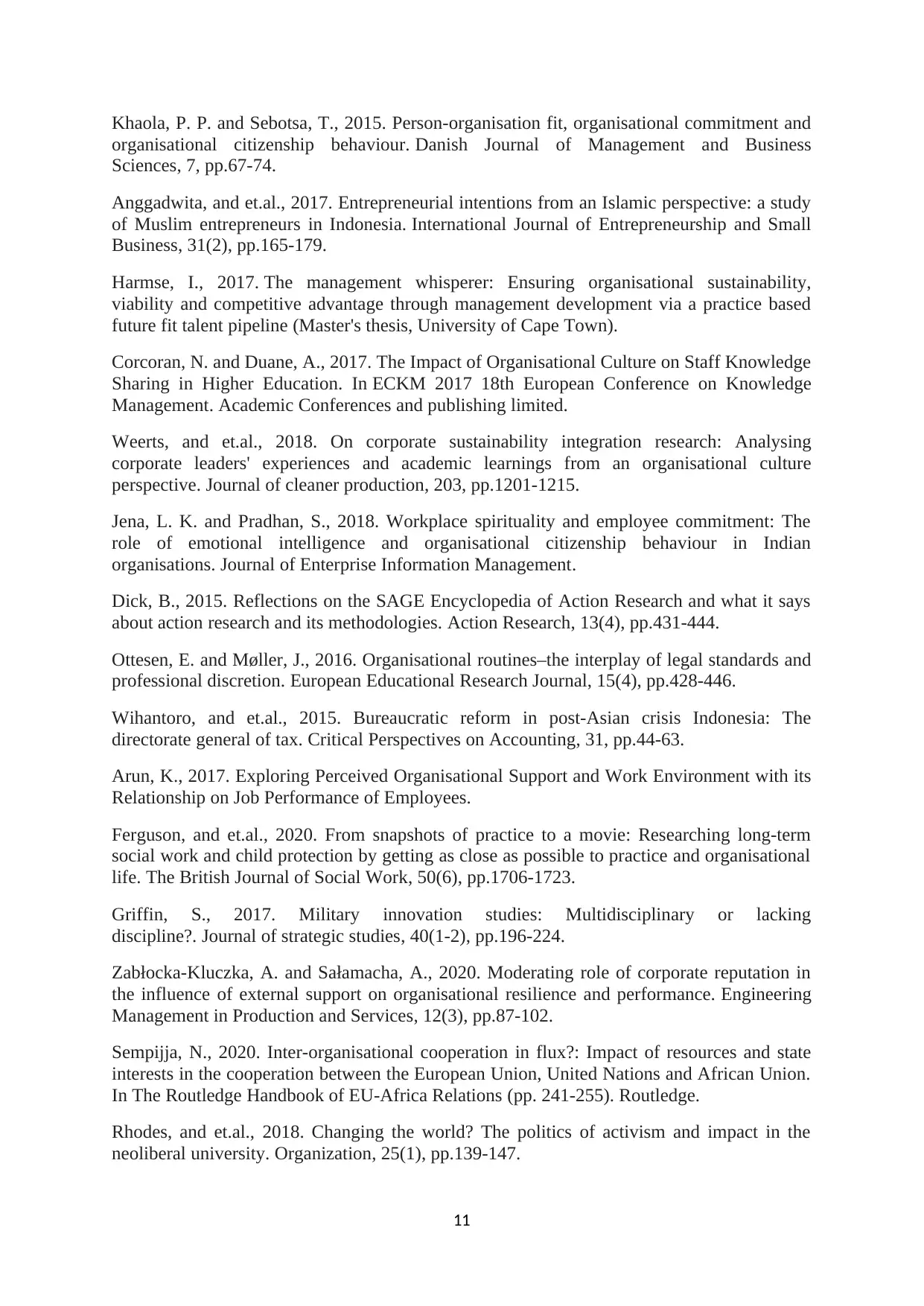
Khaola, P. P. and Sebotsa, T., 2015. Person-organisation fit, organisational commitment and
organisational citizenship behaviour. Danish Journal of Management and Business
Sciences, 7, pp.67-74.
Anggadwita, and et.al., 2017. Entrepreneurial intentions from an Islamic perspective: a study
of Muslim entrepreneurs in Indonesia. International Journal of Entrepreneurship and Small
Business, 31(2), pp.165-179.
Harmse, I., 2017. The management whisperer: Ensuring organisational sustainability,
viability and competitive advantage through management development via a practice based
future fit talent pipeline (Master's thesis, University of Cape Town).
Corcoran, N. and Duane, A., 2017. The Impact of Organisational Culture on Staff Knowledge
Sharing in Higher Education. In ECKM 2017 18th European Conference on Knowledge
Management. Academic Conferences and publishing limited.
Weerts, and et.al., 2018. On corporate sustainability integration research: Analysing
corporate leaders' experiences and academic learnings from an organisational culture
perspective. Journal of cleaner production, 203, pp.1201-1215.
Jena, L. K. and Pradhan, S., 2018. Workplace spirituality and employee commitment: The
role of emotional intelligence and organisational citizenship behaviour in Indian
organisations. Journal of Enterprise Information Management.
Dick, B., 2015. Reflections on the SAGE Encyclopedia of Action Research and what it says
about action research and its methodologies. Action Research, 13(4), pp.431-444.
Ottesen, E. and Møller, J., 2016. Organisational routines–the interplay of legal standards and
professional discretion. European Educational Research Journal, 15(4), pp.428-446.
Wihantoro, and et.al., 2015. Bureaucratic reform in post-Asian crisis Indonesia: The
directorate general of tax. Critical Perspectives on Accounting, 31, pp.44-63.
Arun, K., 2017. Exploring Perceived Organisational Support and Work Environment with its
Relationship on Job Performance of Employees.
Ferguson, and et.al., 2020. From snapshots of practice to a movie: Researching long-term
social work and child protection by getting as close as possible to practice and organisational
life. The British Journal of Social Work, 50(6), pp.1706-1723.
Griffin, S., 2017. Military innovation studies: Multidisciplinary or lacking
discipline?. Journal of strategic studies, 40(1-2), pp.196-224.
Zabłocka-Kluczka, A. and Sałamacha, A., 2020. Moderating role of corporate reputation in
the influence of external support on organisational resilience and performance. Engineering
Management in Production and Services, 12(3), pp.87-102.
Sempijja, N., 2020. Inter-organisational cooperation in flux?: Impact of resources and state
interests in the cooperation between the European Union, United Nations and African Union.
In The Routledge Handbook of EU-Africa Relations (pp. 241-255). Routledge.
Rhodes, and et.al., 2018. Changing the world? The politics of activism and impact in the
neoliberal university. Organization, 25(1), pp.139-147.
11
organisational citizenship behaviour. Danish Journal of Management and Business
Sciences, 7, pp.67-74.
Anggadwita, and et.al., 2017. Entrepreneurial intentions from an Islamic perspective: a study
of Muslim entrepreneurs in Indonesia. International Journal of Entrepreneurship and Small
Business, 31(2), pp.165-179.
Harmse, I., 2017. The management whisperer: Ensuring organisational sustainability,
viability and competitive advantage through management development via a practice based
future fit talent pipeline (Master's thesis, University of Cape Town).
Corcoran, N. and Duane, A., 2017. The Impact of Organisational Culture on Staff Knowledge
Sharing in Higher Education. In ECKM 2017 18th European Conference on Knowledge
Management. Academic Conferences and publishing limited.
Weerts, and et.al., 2018. On corporate sustainability integration research: Analysing
corporate leaders' experiences and academic learnings from an organisational culture
perspective. Journal of cleaner production, 203, pp.1201-1215.
Jena, L. K. and Pradhan, S., 2018. Workplace spirituality and employee commitment: The
role of emotional intelligence and organisational citizenship behaviour in Indian
organisations. Journal of Enterprise Information Management.
Dick, B., 2015. Reflections on the SAGE Encyclopedia of Action Research and what it says
about action research and its methodologies. Action Research, 13(4), pp.431-444.
Ottesen, E. and Møller, J., 2016. Organisational routines–the interplay of legal standards and
professional discretion. European Educational Research Journal, 15(4), pp.428-446.
Wihantoro, and et.al., 2015. Bureaucratic reform in post-Asian crisis Indonesia: The
directorate general of tax. Critical Perspectives on Accounting, 31, pp.44-63.
Arun, K., 2017. Exploring Perceived Organisational Support and Work Environment with its
Relationship on Job Performance of Employees.
Ferguson, and et.al., 2020. From snapshots of practice to a movie: Researching long-term
social work and child protection by getting as close as possible to practice and organisational
life. The British Journal of Social Work, 50(6), pp.1706-1723.
Griffin, S., 2017. Military innovation studies: Multidisciplinary or lacking
discipline?. Journal of strategic studies, 40(1-2), pp.196-224.
Zabłocka-Kluczka, A. and Sałamacha, A., 2020. Moderating role of corporate reputation in
the influence of external support on organisational resilience and performance. Engineering
Management in Production and Services, 12(3), pp.87-102.
Sempijja, N., 2020. Inter-organisational cooperation in flux?: Impact of resources and state
interests in the cooperation between the European Union, United Nations and African Union.
In The Routledge Handbook of EU-Africa Relations (pp. 241-255). Routledge.
Rhodes, and et.al., 2018. Changing the world? The politics of activism and impact in the
neoliberal university. Organization, 25(1), pp.139-147.
11
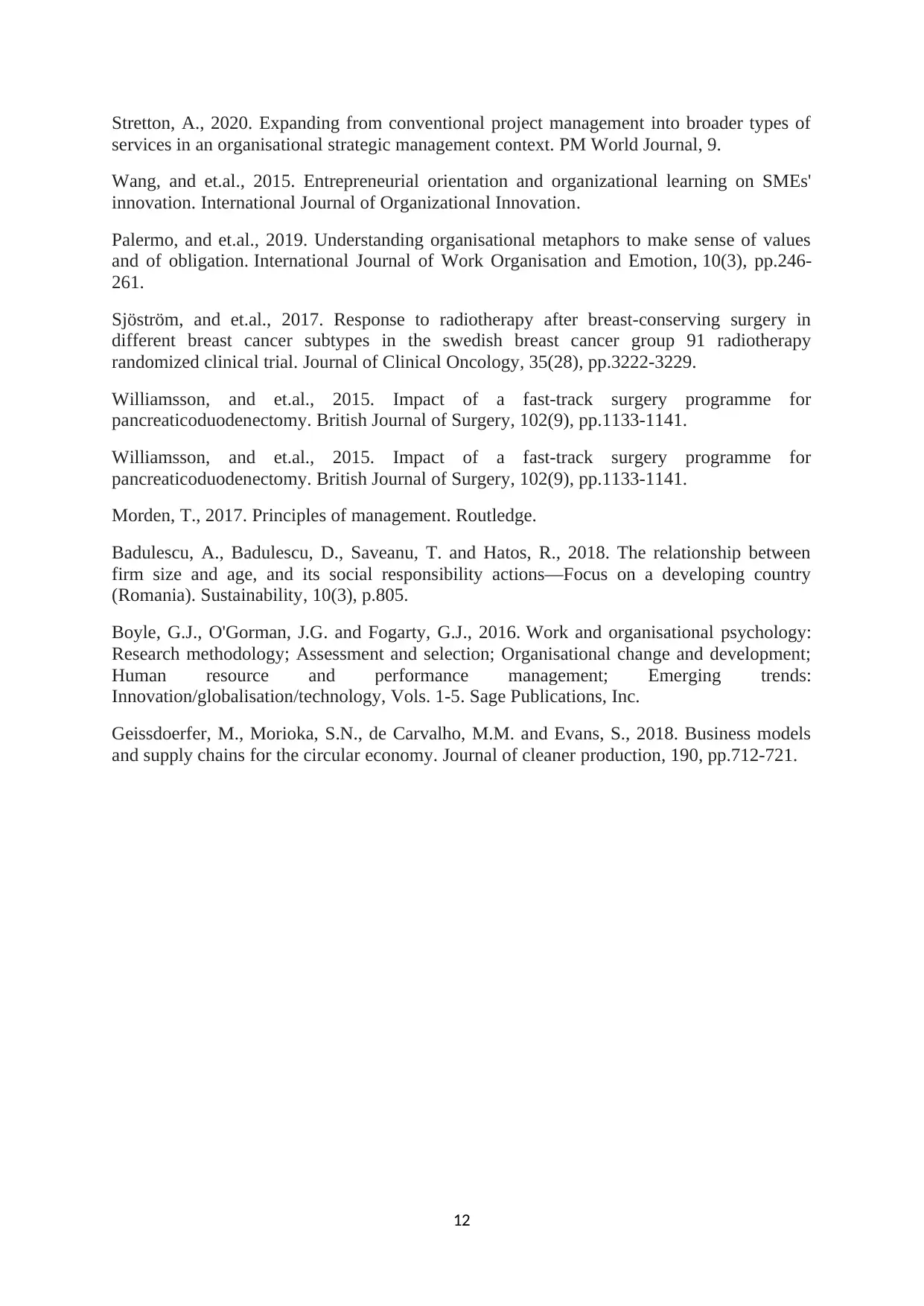
Stretton, A., 2020. Expanding from conventional project management into broader types of
services in an organisational strategic management context. PM World Journal, 9.
Wang, and et.al., 2015. Entrepreneurial orientation and organizational learning on SMEs'
innovation. International Journal of Organizational Innovation.
Palermo, and et.al., 2019. Understanding organisational metaphors to make sense of values
and of obligation. International Journal of Work Organisation and Emotion, 10(3), pp.246-
261.
Sjöström, and et.al., 2017. Response to radiotherapy after breast-conserving surgery in
different breast cancer subtypes in the swedish breast cancer group 91 radiotherapy
randomized clinical trial. Journal of Clinical Oncology, 35(28), pp.3222-3229.
Williamsson, and et.al., 2015. Impact of a fast-track surgery programme for
pancreaticoduodenectomy. British Journal of Surgery, 102(9), pp.1133-1141.
Williamsson, and et.al., 2015. Impact of a fast-track surgery programme for
pancreaticoduodenectomy. British Journal of Surgery, 102(9), pp.1133-1141.
Morden, T., 2017. Principles of management. Routledge.
Badulescu, A., Badulescu, D., Saveanu, T. and Hatos, R., 2018. The relationship between
firm size and age, and its social responsibility actions—Focus on a developing country
(Romania). Sustainability, 10(3), p.805.
Boyle, G.J., O'Gorman, J.G. and Fogarty, G.J., 2016. Work and organisational psychology:
Research methodology; Assessment and selection; Organisational change and development;
Human resource and performance management; Emerging trends:
Innovation/globalisation/technology, Vols. 1-5. Sage Publications, Inc.
Geissdoerfer, M., Morioka, S.N., de Carvalho, M.M. and Evans, S., 2018. Business models
and supply chains for the circular economy. Journal of cleaner production, 190, pp.712-721.
12
services in an organisational strategic management context. PM World Journal, 9.
Wang, and et.al., 2015. Entrepreneurial orientation and organizational learning on SMEs'
innovation. International Journal of Organizational Innovation.
Palermo, and et.al., 2019. Understanding organisational metaphors to make sense of values
and of obligation. International Journal of Work Organisation and Emotion, 10(3), pp.246-
261.
Sjöström, and et.al., 2017. Response to radiotherapy after breast-conserving surgery in
different breast cancer subtypes in the swedish breast cancer group 91 radiotherapy
randomized clinical trial. Journal of Clinical Oncology, 35(28), pp.3222-3229.
Williamsson, and et.al., 2015. Impact of a fast-track surgery programme for
pancreaticoduodenectomy. British Journal of Surgery, 102(9), pp.1133-1141.
Williamsson, and et.al., 2015. Impact of a fast-track surgery programme for
pancreaticoduodenectomy. British Journal of Surgery, 102(9), pp.1133-1141.
Morden, T., 2017. Principles of management. Routledge.
Badulescu, A., Badulescu, D., Saveanu, T. and Hatos, R., 2018. The relationship between
firm size and age, and its social responsibility actions—Focus on a developing country
(Romania). Sustainability, 10(3), p.805.
Boyle, G.J., O'Gorman, J.G. and Fogarty, G.J., 2016. Work and organisational psychology:
Research methodology; Assessment and selection; Organisational change and development;
Human resource and performance management; Emerging trends:
Innovation/globalisation/technology, Vols. 1-5. Sage Publications, Inc.
Geissdoerfer, M., Morioka, S.N., de Carvalho, M.M. and Evans, S., 2018. Business models
and supply chains for the circular economy. Journal of cleaner production, 190, pp.712-721.
12
⊘ This is a preview!⊘
Do you want full access?
Subscribe today to unlock all pages.

Trusted by 1+ million students worldwide
1 out of 12
Related Documents
Your All-in-One AI-Powered Toolkit for Academic Success.
+13062052269
info@desklib.com
Available 24*7 on WhatsApp / Email
![[object Object]](/_next/static/media/star-bottom.7253800d.svg)
Unlock your academic potential
Copyright © 2020–2025 A2Z Services. All Rights Reserved. Developed and managed by ZUCOL.





